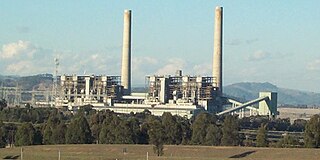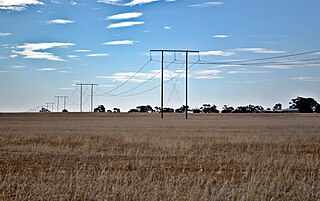
Electricity generation is the process of generating electric power from sources of primary energy. For utilities in the electric power industry, it is the stage prior to its delivery to end users or its storage.

Liddell Power Station is a coal-powered thermal power station with four 500 megawatts (670,000 hp) GEC steam driven turbine alternators for a combined electrical capacity of 2,000 megawatts (2,700,000 hp).
Northern Power Station was located at Port Paterson in the Australian state of South Australia about 6 kilometres (3.7 mi) south of the city centre of Port Augusta. It was coal powered with two 260 MW steam turbines that generated a total of 520 MW of electricity. It was operated and maintained by Alinta Energy and was commissioned in 1985. Northern received coal by rail from the Leigh Creek Coal Mine, 280 km to the north. The plant ceased electricity production in May 2016 and decommissioned and demolished over the following few years.

AGL Energy Ltd is an Australian listed public company involved in both the generation and retailing of electricity and gas for residential and commercial use. AGL is Australia's largest electricity generator, and the nation's largest carbon emitter. The company has an operated generation capacity of 10,984 MW. 85% of the company's generation comes from the burning of coal. The company emits 42,227,180 Total Scope 1 Emissions. AGL is also a significant investor, owner, and operator, of renewable energy assets.

The energy policy of Australia is subject to the regulatory and fiscal influence of all three levels of government in Australia, although only the State and Federal levels determine policy for primary industries such as coal. Federal policies for energy in Australia continue to support the coal mining and natural gas industries through subsidies for fossil fuel use and production. Australia is the 10th most coal-dependent country in the world. Coal and natural gas, along with oil-based products, are currently the primary sources of Australian energy usage and the coal industry produces over 30% of Australia's total greenhouse gas emissions. In 2018 Australia was the 8th highest emitter of greenhouse gases per capita in the world.

Wind power became a significant energy source within South Australia over the first two decades of the 21st century. In 2015, there was an installed capacity of 1,475 MW, which accounted for 34% of electricity production in the state. This accounted for 35% of Australia's installed wind power capacity. In 2021, there was an installed capacity of 2052.95 MW, which accounted for 42.1% of the electricity production in the state in 2020.

Lake Bonney Wind Farm, in South Australia, was built in three stages. Stage 1 comprises 46 turbines each having a rated capacity of 1.75 MW and was finished in March 2005. Construction of Stage 2 began in November 2006 and was finished around April 2008. Stage 2 comprises 53 turbines of 3 MW. Stage 3 comprises 13 turbines of 3 MW of total 39 MW). Stage 3 construction commenced in February 2009 and was commissioned in September 2009.
The Whirinaki Power Station is an open cycle gas turbine power station at Whirinaki, Hawke's Bay in New Zealand.
Port Stanvac Refinery was an oil refinery in the Australian state of South Australia located in Lonsdale, a southern suburb of Adelaide. Its construction was announced in 1958 and began refining crude oil in 1963.
South Australia is a leader in utility-scale renewable energy generation, and also produces gas and uranium for electricity generation. Gas production is mostly concentrated in the Cooper Basin in the state's north-east. Gas is delivered from these fields by pipeline to users interstate and to Port Adelaide where it fuels three separate gas-fired power plants. Uranium is also mined in South Australia, though nuclear power generation is prohibited nationally. The Olympic Dam mine is the world's single largest known deposit of uranium and represents 30% of the world's total uranium resource. Many utility-scale wind farms and solar farms have been commissioned during the 21st century and geology with potential for geothermal energy has also been identified but is yet to be developed.
The 2016 Tasmanian energy crisis was an ongoing energy storage situation in the state of Tasmania, Australia in 2016. Two years of high volumes of energy exported to Victoria via the Basslink HVDC cable, followed by low rainfall, and a fault which rendered the cable inoperable, resulted in record low storage levels in Tasmania's hydro-electric system. This resulted in a number of contingency plans to be enacted by Hydro Tasmania and the Hodgman Government.
The South Australian blackout of 2016 was a widespread power outage in South Australia that occurred as a result of storm damage to electricity transmission infrastructure on 28 September 2016. The cascading failure of the electricity transmission network resulted in almost the entire state losing its electricity supply, affecting 850,000 SA customers. Kangaroo Island did not lose its supply, as the Kangaroo Island power station had been built to supply the island for the contingency of a failure in the power cable under the Backstairs Passage.
The Hornsdale Wind Farm is an electricity generator in the locality of Hornsdale in the south-west of the Narien Range, north of Jamestown, South Australia. It consists of 99 wind turbines with a generation capacity of 315 megawatts (422,000 hp). The plant is owned and operated by Neoen, a French renewable energy company.

Reeves Plains Power Station is a proposal from Alinta Energy to build a gas-fired power station at Reeves Plains between Gawler and Mallala in South Australia. The proposed site borders both the Moomba-Adelaide gas pipe and an electricity transmission line. The power station is proposed to use six gas turbines to produce up to 300 megawatts (400,000 hp) of electricity. It is expected to be operated as a peaking plant rather than running full time. The primary source of fuel will be the gas pipeline, however the plant will also be able to operate on diesel fuel, and will have diesel storage on site. Stage 1 is expected to only be two or three of the turbines, generating 100 to 150 MW of electricity. The power station was originally expected to take 12 months to build, and be commissioned in January 2019. An extension of time request granted an additional 12 months in February 2019, but as of November 2019, the Alinta board had not yet decided to make the investment.
Lonsdale Power Station is a diesel-powered electricity generator in South Australia in Lonsdale, an industrial southern suburb of Adelaide. It is owned by Snowy Hydro since 2014. It consists of 18 diesel reciprocating engines generating up to 21MW of electricity to meet peak demands in the National Electricity Market.
Channel Island Power Station is the largest power station in the Northern Territory of Australia. It is positioned on an island in the Middle Arm of Darwin Harbour, supplying electricity to the Darwin-Katherine Interconnected System. It is currently owned and operated by Territory Generation. Most of the island surrounding the facility is protected from development as the Channel Island Conservation Reserve.
Temporary Generation North and its smaller sibling Temporary Generation South were gas turbine power stations in South Australia. They were bought by the Government of South Australia in 2017 as a response to the 2016 South Australian blackout and load-shedding in February 2017.
Nexif Energy is a Singapore-based company that owns and operates wind farms and other renewable energy projects in several countries. It is a joint venture of Nexif and Denham Capital founded in August 2015.







